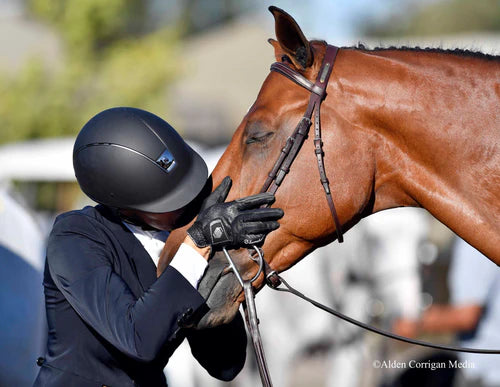You know your clothing size, but do you know your horses?
As temperatures start to drop and weather conditions take a turn, here in the South East our customers begin thinking of purchasing new horse blankets. The question that we get asked the most often, regardless of blanket type, is “What size does my horse need?”
Fit is, in fact, the most important consideration when purchasing a new equestrian blanket. An improperly fitting blanket, besides being uncomfortable for your horse, can restrict movement, entrap your horse, or cause painful rubs.
Properly determine your horse’s blanket size by:
- With a soft cloth measuring tape, start at the center of your horse’s chest, where the base of the neck reaches the chest, to the point where you would like the blanket to end. Some horse owners prefer their blankets to be long enough to cover the top of their horse’s tail (especially for turnout blankets) or end just short of the tail.
- Be sure to run the tape over the point of your horse’s shoulder and along its side, keeping it taunt.
- The inch measurement will be your horse’s blanket size.

Please keep in mind that, as horses come in all shapes and sizes, horse blankets are available in a plethora of different styles and cuts. Some brands run large, some small, some wide, and some narrow.
When tying blankets on your horse pay attention to:
- How the blanket fits your horse’s shoulders. The neckline should lie smoothly across the shoulder without pulling or gaping, and the top of the front closure should line up with the point of the shoulder.
- To protect your horse’s sensitive withers, you should be able to slide one hand between the blanket and its withers.
- Your horse’s blanket should cover its barrel and end just above its knees. If it looks like your horse is wearing a mini skirt or long ball gown, it does not fit properly.
- Use an appropriately sized surcingle to securely fasten the blanket in place. Surcingles come in various materials, sizes, and styles to best fit your horse and keep the blanket stable.
- Watch your horse walk and graze while wearing the blanket, as these movements will highlight any fit flaws. Blankets must fit properly while your horse is moving as well as standing still.
- Finally, if you're able, put a clean old sheet on your horse to try potential blankets over. Your favorite tack shop will appreciate it.
As for horse blanket cuts, keep in mind your horse’s conformation when deciding what cut may work best. If you are finding that your horse’s blankets fit too snugly in the chest, shoulders and /or wither, blankets that have a cut back wither or fit more broadly may help. If your blanket hangs too low, a blanket with a shorter drop may be beneficial. If your horse has high withers, you may find that your blanket is causing rubs. High neck, or combo neck blankets, will help to relieve pressure and have the added benefit of protecting horses that are outside in the elements from rain or snow running down their neck. Neck covers can also be used for additional protection and warmth for the neck area when needed.
Different Weights and Materials for Different Weather
Horse blankets come in a variety of weights to provide different levels of warmth.
- The lightest blankets are summer sheets, coolers, and anti-sweat sheets usually made of a lightweight material like cotton or mesh. These are designed to protect the coat, wick away sweat on hot days and be breathable.
- As well as medium and heavy turnout blankets, there are also "no-fill" options. These provide an light level of warmth with a durable outer shell but no internal insulation or fill. No-fill blankets are useful for temperamental fall and spring weather.
- Medium-weight blankets include turnout blankets as well as stable blankets. These work well for cooler winter days and nights.
- The heavy weight blankets are winter turnout blankets, typically made of materials like 1200D ripstop polyester with insulation. The denier rating (abbreviated D) refers to the density of the fibers in the material. A higher denier rating indicates thicker, more durable fabric. These winter horse blankets are thick, durable blankets intended to keep horses warm and dry through cold weather and wet winters.
Choosing the right weight for your climate and your horse's needs is important for their comfort.
M&M Tack Shop experts are here for you and your horses.
If you have questions on what horse blankets or stable blankets may meet your horse’s needs, our expertly trained staff will be happy to help. We carry a wide selection of quality horse blankets including scrims for summer, lites and mediums for spring and fall, and heavy weights for winter. We have styles like combo necks for coverage, fly sheets for insect protection, and blanket liners to boost warmth. With brands like Weatherbeeta, Amigo, Rhino, and more, we have the right horse care products to keep your horse comfortable in any condition. Our friendly staff can help you find the perfect blankets, sheets, coolers, and accessories for your foal, pony, or horse.
Please call 919.851.0102 or email us at questions@mmtackshop.com and be sure to shop our wide selection of quality horse blankets to find the perfect fit for your horse!





